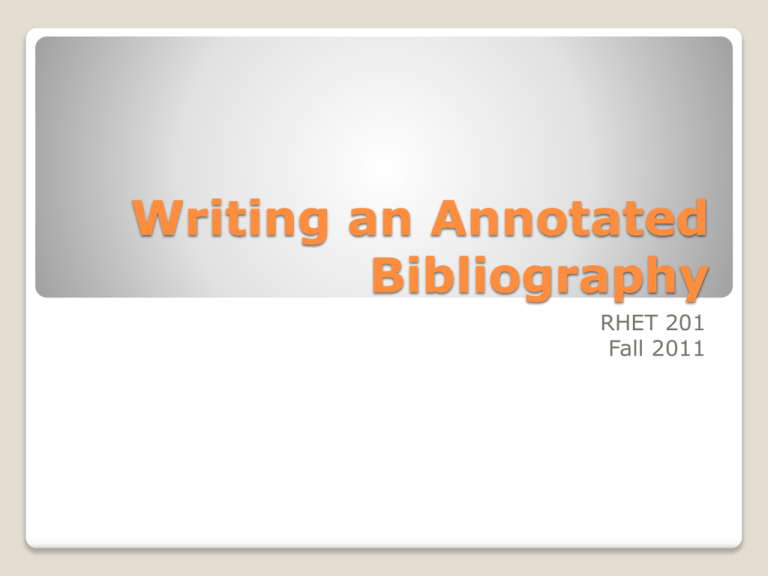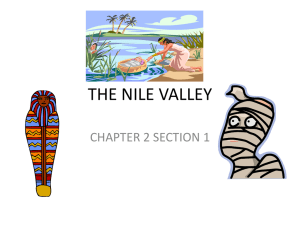Writing an Annotated Bibliography - The American University in Cairo
advertisement

Writing an Annotated Bibliography RHET 201 Fall 2011 A list of citations of books, articles, and documents related to a research question or topic. Each citation is followed by descriptive and evaluative paragraph or two, the annotation. The purpose of the annotation is to inform the reader of the content of the source, its significance, relevance, POV, accuracy, and quality. WHAT IS AN ANNOTATED BIBLIOGRAPHY? First: Define your topic or research question. Search for sources related to this topic. You will primarily be looking for scholarly books and articles, but your search may also include credible and substantial newspaper and magazine articles, films and videos, white papers and other materials from NGOS or government organizations, and even blog entries in some cases. EVALUATE the credibility and usefulness of the sources you find and the relevance to your project. Then choose those works that provide a variety of perspectives on your topic. Process Cite the book, article, or document using MLA style. Write a concise annotation that: 1. Summarizes the thesis or central theme and scope of the book or article and the perspective from which it is written. 2. Evaluates the types and qualities of support/evidence used in the article. 3. Comments on the intended audience, and possibly the authority and background of the author, if significant. 4. Compares or contrasts this work with another you have cited 5. Explains how this work is related to your research question. Process Where is it published? Who wrote it? Where did you find it? How does it relate to other materials on the topic/issue? What is the quality of the support used? What types of sources are cited? For more info see: How to Critically appraise information sources http://olinuris.library.cornell.edu/ref/research/ski ll26.htm How to evaluate & analyze sources Waite, Linda J., Frances Kobrin Goldscheider, and Christina Witsberger. "Nonfamily Living and the Erosion of Traditional Family Orientations Among Young Adults." American Sociological Review 51.4 (1986): 541-554. Print. The authors, researchers at the Rand Corporation and Brown University, use data from the National Longitudinal Surveys of Young Women and Young Men to test their hypothesis that nonfamily living by young adults alters their attitudes, values, plans, and expectations, moving them away from their belief in traditional sex roles. They find their hypothesis strongly supported in young females, while the effects were fewer in studies of young males. Increasing the time away from parents before marrying increased individualism, self-sufficiency, and changes in attitudes about families. In contrast, an earlier study by Williams cited below shows no significant gender differences in sex role attitudes as a result of nonfamily living. Sample Ehrenreich, Barbara. Nickel and Dimed: On (not) Getting by in America. New York: Henry Holt and Company, 2001. Set in the late 1990’ this book of nonfiction sets out to investigate the impact of the 1996 welfare reform on the "working poor" in the United States. It is based on the journalist's experiential research, as the author, Barbara Ehrenreich, attempts to ascertain whether it is currently possible for an individual to live on a minimum-wage in America. Taking jobs as a waitress, a maid in a cleaning service, and a Wal-Mart sales employee, the author documents, summarizes and reflects on her work, her relationships with fellow workers, and her financial struggles in each situation. These experiences serve as the basis for the implicit argument that it is nearly impossible for minimum wage workers in America to maintain a decent standard of living. An experienced journalist, Ehrenreich is aware of the limitations of her experiment and the ethical implications of her experiential research tactics and reflects on these issues in the text. The author discusses her methods and supplements her experiences with scholarly research on her places of employment, the economy, and the rising cost of living in America. In the end she concludes that someday, low-wage workers will rise up and demand to be treated fairly, and when that day comes everyone will be better off. This book will be useful to my research on the debate about the minimum wage in the US because it provides first hand experience of the challenges of living on a minimum wage job as well as the difficult working conditions of many low wage jobs. The scholarly data included is out of date now, but it gives me ideas about the kinds of statistics I should look for in more recent articles. Sample Amer, Salah El-Din, and Magdy Hefny. "Egypt and the Nile Basin." Aquatic Sciences 67.1 (2005): 42-50. Print. Salah El-Din Amer, Professor of International law, Cairo University, and Magdy Hefny, Director, Regional Center for Studies and Research on Water Ethics, use data from the Web of Science; and they are generally talking about the problem of water in Egypt and the other countries as they will face lack of water if they don’t save water. They also mention that there are some conflicts between them, and also there are a lot of policies and deals according to the water of the Nile “On the water resources development side, the strategies are more focused on enhancing cooperation among the Nile Basin countries in order to implement joint projects that could increase the countries water budget from the Nile.” They said that there are a lot of policies between these countries such as the 1929, and 1959 agreements. So it will help me in the recent conflict between Egypt and Ethiopia and the other countries as it will show the demands of each country, and who has the right in this conflict and what are the causes that lead to this conflict after deals between them. It is different for the other articles as it discuss the ways of cooperation between the Nile Basin countries such as the NBI and its objectives. Student Sample Salem, M. et al. “Studies On John's Disease In Egyptian Cattle.” Journal Of Veterinary Medicine Series B 52.3 (2005) : 134-137. Web. 26 Mar 2011. In this paper, the authors discussed the incidence of a disease called John’s Disease in Egyptian cattle. This disease is a form of tuberculosis that affects cattle. The authors said that Egypt was thought to be free of JD but, the study performed by the authors showed Egypt has a large percentage of cattle that are affected by this disease. Their study was done on 160 Egyptian cattle and samples from their feces were analyzed to determine whether they are diseased or not. Fecal samples were used because the disease operates in the intestine so, large populations of the bacterium are found in feces. The data used by the study is mainly statistical as well as some scientific jargon and methodologies. The study showed that 51% of the samples that were taken from cows exhibiting symptoms were positive and 44% of the samples from animals exhibiting no symptoms were positive. The study also showed that the incidence of JD was highest in Ismailia followed by El Monefeia and Cairo, El Giza and El Gharbeiah reported no positive results for JD. I believe that this study is of relative importance to my argument because it shows the effect of the spread of pollution and the use of pesticides on the crops. JD is an intestinal disease therefore the most probable cause of its spread is from polluted food and the pollution is most probably caused by the excessive use of highly toxic pesticides. The correlation between the JD disease and pesticides are not mentioned in the study but they can be inferred from the data and the nature of the disease. Student Sample





